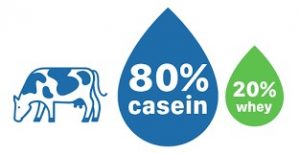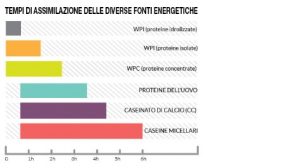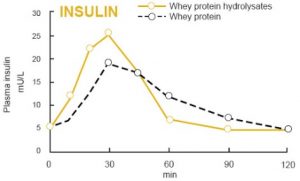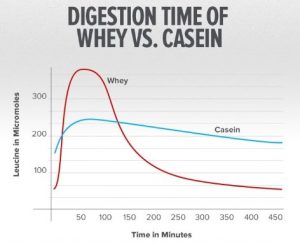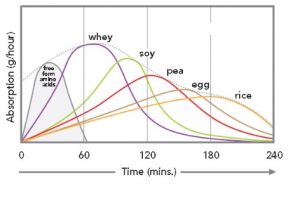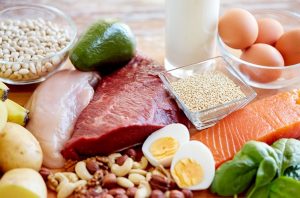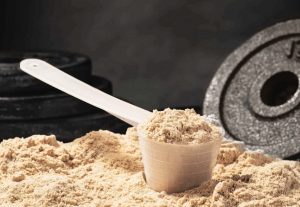Biological value (VB)
We cannot talk about nutrition and protein supplementation, without talking about biological value (VB), a very important concept.
In fact, it is a parameter that allows to determine the quality of proteins, which can also be classified according to their biological value.
Obviously it is not the only parameter, which can be used to state whether a protein is of high quality or not, and proteins can be classified, and grouped according to other criteria, but to this day the VB system remains the most known and widespread.
In expressing what biological value is, I have to be as clear and exhaustive as possible, and to do this I will give the technical definition, and then I will explain it at the concept level.
The biological value is a parameter, it is represented by a number, and it is given by the ratio between the nitrogen values.
Below I indicate the formula by which it is calculated:
Fig. 1 - Formula for calculating the biological value
N is the chemical symbol for nitrogen, and it is based on the quantity of nitrogen that the biological value of proteins (or foods in general) is established.
The fecal and urinary nitrogen values are detected only by laboratory tests.
In short, in order to calculate the VB it is necessary that someone eats a certain food, or takes a certain protein, then the laboratory tests begin, and only when you have all the values to be entered in the above formula can the VB be calculated.
The biological value is a real index of the quality of proteins, which takes into account the nitrogen taken and that actually retained, the one expelled obviously can never be used by our body. Proteins are made up of amino acids, and a protein to have a high biological value must have all the essential amino acids, and these must also be present in the right proportions between them (balanced dosage). Why are we referring to essential amino acids? Because our body cannot produce them autonomously, so we can only introduce them through nutrition and supplementation. If only one essential amino acid (EAA) were present in too little quantity compared to the others, it would limit the ability to make protein synthesis also to the other amino acids.
The amino acid present in a small percentage causes an imbalance in the amino acid spectrum, or amino acid profile, if you prefer, of the protein in question, and this amino acid is called limiting amino acid, because, as just said, it limits the possibility of protein synthesis to the other amino acids.
However, all this is not enough, in order for a protein to have a high VB, the protein in question must also be well digested.
Ultimately it can be said that a protein has a high VB if it is easily digestible and if it has a complete and well balanced amino acid profile; a protein of high biological value is particularly effective in carrying out protein synthesis.
Proteins that possess a high VB are of high quality, and are also referred to as noble proteins.
Different protein sources and related biological values: Generalities and clarifications
The biological value is a number that is placed on a scale of values ranging from 0 to 100, egg proteins are attributed VB equal to 100, which by convention is the maximum ... but is this really the case?
At this point, as they say in the jargon "A world opens up", and important considerations must be made:
Following the canonical formula that allows to establish the biological value, some authors (they are scientists-researchers), attribute these values to various protein sources:
| Food | Biological value |
| EGGS | 100 |
| MILK | 91 |
| BEEF | 80 |
| FISH | 78 |
| SOY PROTEIN | 74 |
| RICE | 59 |
| WHEAT | 54 |
| PEANUTS | 43 |
| POTATO | 34 |
Tab. 1 - Examples of the biological value of some foods
However, reality prevails over formulas, because calculating the biological value is not easy.
The same scientific community is still committed to important evaluations regarding biological value, and its determination.
Some researchers, who in light of this, in the evaluation of the biological value take into account other parameters, such as the ease or difficulty in digesting a specific protein under examination; Furthermore, fecal metabolic nitrogen must be considered, not deriving from proteins, but from:
- digestive enzymes
- mucous membranes of the digestive tract
- bile juices
- catabolites or residues of bacterial (physiological) flora
- endogenous urinary nitrogen from tissue turnover (purines)
Furthermore, it should be considered that the fact of the amino acid pattern affects the biological value, i.e. how much the arrangement of amino acids within a protein resembles our amino acid pattern.
The more similar a protein is to human proteins, the higher the biological value of that protein will be.
Milk's proteins
Before going into the subject it is necessary to make a clarification:
The protein fraction of milk is made up of 2 parts, one is represented by whey, and composes it for 20%, and the other is represented by caseins, which composes it for the remaining 80%.
Whey are whey proteins (of the "aqueous" part), caseins are milk proteins, but NOT whey.
From the sum of the protein fraction of whey (20%), and that of caseins (80%), the 100% of the milk protein fraction is obtained.
Obviously, reference is made to cow's milk, (in human milk the distribution of the protein fraction is different).
Fig. 2 - Casein / whey ratio in the protein fraction in cow's milk
Whey is a generic term, this is because whey protein means whey (milk) proteins, but it indicates a category of proteins, and not a specific protein, there are in fact 3 types of whey protein: concentrated, hydrolyzed, isolated.
All 3 types of whey proteins have a very high biological value in common, but which varies according to the type of whey.
All 3 types of whey are very effective in inducing protein synthesis, yet they have different characteristics from each other.
Some authors attribute to whey proteins a minimum BV of 106 to a maximum BV of 159, why?
Because, as just mentioned, there is not just one type of Whey, but 3 types, the incredible value of 159 is possessed by the whey isolates, while 106 is the biological value of the concentrates.
But then, how can the sportsman orient himself between so many and different sources of protein?
In reality it is much simpler than it might seem, let's go in order and start making the necessary clarity:
Whey isolates have the highest biological value ever.
These proteins are called isolate, because they are isolated from lactose, which is a sugar, a di-saccharide made up of glucose and galactose.
This also makes them suitable for lactose intolerant, ie those who have little protease enzyme, which serves to divide glucose from galactose, and therefore to digest lactose well.
Whey protein isolate is the protein with the lowest percentage of fats and carbohydrates compared to other whey proteins, and to all other protein sources.
Isolate whey proteins have an ideal amino acid profile.
With these premises, it becomes almost "normal" that they have such a high biological value.
On the other hand there are concentrated whey proteins, which in some tables have a VB of 104 rather than 106 but it doesn't matter.
Among the whey are those with more fats and carbohydrates, but it should be noted that we always talk about very small percentages.
But then should we discard the concentrates and take only the isolated ones? No, this is not the case.
At the end of the workout there is a lowering of the immune system's guard level, and whey concentrate seems to be the most effective in bringing the immune system back to optimal levels.
This is because they are the least denatured, those with the slowest assimilation among the whey, and with more satiating power than the other whey proteins.
For those looking for a very technical product, or pay attention to even the minimum dose of fats and carbohydrates, or especially if they are lactose intolerant, I do not recommend taking concentrates, and I recommend taking isolates.
For those looking for a product with a high biological value, but also with a high completeness of "biological action" I recommend concentrates.
Hydrolyzed whey proteins are closest as VB to isolates, further away from concentrates, and are by far the most rapidly assimilated proteins. They are called hydrolyzed because they undergo an enzymatic hydrolysis process, in practice the amino acid chains of which these proteins are composed are considerably shortened.
Once we take them, our body takes very little time to assimilate the amino acids that compose them.
They have a slightly higher percentage of lactose than isolates, but lower than concentrates.
They are the proteins that absolutely produce the greatest insulin stimulus, excellent for facilitating the absorption of creatine, as well as very effective in inducing protein synthesis.
Fig. 3 - Comparison between various protein sources as a function of assimilation time
In conclusion, the comparison between whey, hydrolysates and isolates are the most technical and effective in inducing protein synthesis; the concentrates still have a VB higher than 100, therefore they are also effective in inducing protein synthesis, even if less technical than the other 2 types of whey.
Fig. 4 - Insulin peak due to hydrolysates compared to concentrates
The other proteins of milk, but not of whey, are caseins, and have a biological value of 80, and are the slowest assimilable proteins of all.
With these characteristics one would say that the only protein sources worth taking are whey, and it is better to avoid caseins, but is it really so? No.
Wheys are very effective in building new muscle, while caseins are very effective in maintaining existing muscles.
The whey, more or less, are quickly assimilated, they are generally good to be taken close to training, while the caseins must be taken away from training.
The human body takes a short time to assimilate the amino acids that form whey proteins, because they are quick to digest.
On the contrary, caseins have a micellar structure, and this means that the body takes a long time to digest them, there is a constant and prolonged release of amino acids over time.
After the intake of whey, a real peak of amino acid concentration is created in the blood, after the intake of caseins this does not happen, no peak of plasma amino acid concentration is created.
In conclusion, whey are no better than caseins, and vice versa, there is simply only a different intended use.
Fig. 5 - Comparison between whey (concentrate) and casein as a function of digestion time
Egg protein
Now we come to egg proteins, they are always proteins of animal origin, therefore of high biological value, in fact their VB is 100, and these proteins are also called noble proteins.
Their assimilation time is halfway between whey and caseins, they are neither rapidly assimilated nor slow-releasing amino acids.
Their intake creates a peak in plasma amino acid concentration, but not as significant as that created by whey.
It should be borne in mind that these proteins have a balanced amino acid profile, the most similar to that of human muscle, therefore, in these terms they represent the reference protein source in the calculation of the chemical index, that is a parameter that shows us whether the arrangement of amino acids within a given protein is good or not, but which does not establish the quality of a protein.
Those who, between one meal and another, placed a few hours apart, want to keep the concentration of amino acids in the blood high, and provide valuable nourishment to the muscles, finds a good ally in egg proteins.
They are not quick to digest, but they are still easy to digest.
Soy protein
Soy proteins are suitable for all vegetarian or vegan athletes, or for those looking for a good protein source of plant origin.
The fact that in the various tables, soy has a biological value of 74 should not suggest that it is a protein source of series B.
There are excellent soy-based protein supplements, which out of 30 grams of product have a good 25 grams of protein.
Soy proteins produce a noteworthy peak in amino acid concentrations in the blood, not the same as that produced by whey, but higher than that induced by egg proteins.
Fig. 6 - Comparison between various protein sources as a function of digestion time
Read also:


